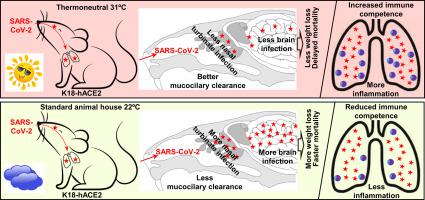Science of the Total Environment ( IF 8.2 ) Pub Date : 2022-11-14 , DOI: 10.1016/j.scitotenv.2022.160163 Troy Dumenil 1 , Thuy T Le 1 , Daniel J Rawle 1 , Kexin Yan 1 , Bing Tang 1 , Wilson Nguyen 1 , Cameron Bishop 1 , Andreas Suhrbier 2

|
Warmer climatic conditions have been associated with fewer COVID-19 cases. Herein we infected K18-hACE2 mice housed at the standard animal house temperature of ∼22 °C, or at ∼31 °C, which is considered to be thermoneutral for mice. On day 2 post infection, RNA-Seq analyses showed no significant differential gene expression lung in lungs of mice housed at the two temperatures, with almost identical viral loads and type I interferon responses. There was also no significant difference in viral loads in lungs on day 5, but RNA-Seq and histology analyses showed clearly elevated inflammatory signatures and infiltrates. Thermoneutrality thus promoted lung inflammation. On day 2 post infection mice housed at 31 °C showed reduced viral loads in nasal turbinates, consistent with increased mucociliary clearance at the warmer ambient temperature. These mice also had reduced virus levels in the brain, and an ensuing amelioration of weight loss and a delay in mortality. Warmer air temperatures may thus reduce infection of the upper respiratory track and the olfactory epithelium, resulting in reduced brain infection. Potential relevance for anosmia and neurological sequelae in COVID-19 patients is discussed.
中文翻译:

在 COVID-19 的 K18-hACE2 小鼠模型中,温暖的环境空气温度可减少鼻甲和脑部感染,但会增加肺部炎症
气候变暖与 COVID-19 病例减少有关。在这里,我们感染了 K18-hACE2 小鼠,这些小鼠饲养在标准动物舍温度 ~22 °C 或 ~ 31 °C,这被认为对小鼠来说是热中性的。感染后第 2 天,RNA-Seq 分析显示在两种温度下饲养的小鼠肺部基因表达没有显着差异,病毒载量和 I 型干扰素反应几乎相同。第 5 天肺部病毒载量也没有显着差异,但 RNA-Seq 和组织学分析显示炎症特征和浸润明显升高。因此,热中性促进了肺部炎症。在感染后第 2 天,饲养在 31°C 的小鼠显示鼻甲中的病毒载量减少,这与在较温暖的环境温度下粘膜纤毛清除率增加一致。这些老鼠大脑中的病毒水平也降低了,随之而来的是体重减轻的改善和死亡率的延迟。因此,较高的气温可能会减少上呼吸道和嗅觉上皮细胞的感染,从而减少脑部感染。讨论了 COVID-19 患者嗅觉丧失和神经系统后遗症的潜在相关性。











































 京公网安备 11010802027423号
京公网安备 11010802027423号